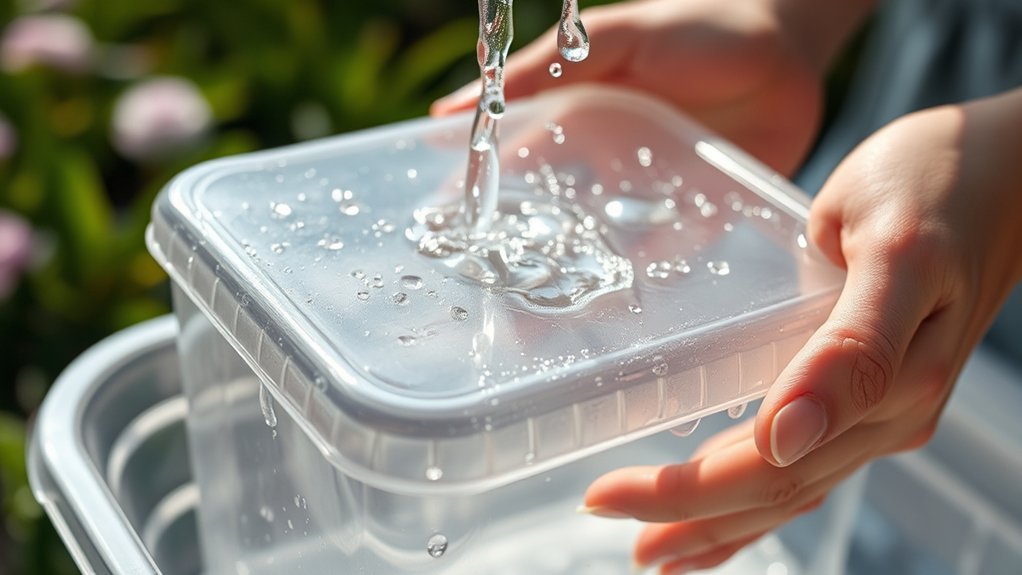Imagine a race car that’s lost its shine, its performance diminished by grime and neglect. Just like that vehicle, your washing carriers can show clear signs of wear and contamination. From visible dirt buildup to unpleasant odors, these indicators signal it’s time for a thorough cleaning. But how do you know when to take action, and what steps should you follow to guarantee your carriers remain in top shape?
Common Contaminants Found in Washing Carriers
Washing carriers often harbor a variety of common contaminants that can compromise their effectiveness and safety. You’re likely to encounter several contaminant types, including bacteria, mold, and chemical residues.
These unwanted invaders can thrive in damp environments, undermining your efforts to maintain hygiene. Effective washing techniques are vital to combat these hazards. Utilizing hot water, appropriate detergents, and thorough rinsing can notably reduce the presence of these contaminants.
It’s important to regularly assess your washing methods, ensuring you’re not just moving dirt around but genuinely eliminating it. By staying vigilant and adopting efficient washing practices, you can liberate your environment from harmful agents, ultimately enhancing the safety and longevity of your washing carriers.
Visible Signs of Dirt and Wear
Contaminants can manifest visibly, signaling dirt and wear on your washing carriers. You might notice dirt buildup in the seams and grooves, indicating a need for cleaning or maintenance.
Pay attention to wear indicators such as frayed edges, discoloration, or uneven texture. These signs reveal that your carriers are under stress and may not perform at their finest.
Regular inspection helps you catch these issues early, allowing you to take corrective action before they escalate. Remember, visible signs aren’t just cosmetic; they directly affect the efficiency and lifespan of your carriers.
Unpleasant Odors and Their Implications
An unpleasant odor emanating from your washing carriers can be a clear indicator of underlying issues. Identifying the odor sources is essential to maintaining a clean and efficient environment.
Often, these smells signal bacteria growth, which can compromise both your carriers and the items you wash.
Consider these common odor sources:
- Mold and mildew: Often found in damp areas, they thrive in wet conditions.
- Food residue: Leftover particles can decay and produce foul smells.
- Neglected cleaning: Regular maintenance prevents bacteria buildup.
- Chemical reactions: Mixing certain detergents can create unpleasant odors.
Addressing these issues not only enhances your washing experience but also liberates your mind from the worry of contamination.
Frequency of Use and When to Clean
While you might think that frequent use of your washing carriers keeps them clean, it’s crucial to establish a regular cleaning schedule.
Adhering to frequency guidelines will help maintain their integrity and effectiveness. If you use your carriers daily, aim to clean them weekly. For less frequent use, a bi-weekly schedule may suffice.
Pay attention to signs of wear or odors, which indicate it’s time for a thorough cleaning. Employ effective cleaning techniques, such as using mild detergent and warm water, to eliminate dirt and bacteria.
Best Practices for Cleaning and Maintenance
To keep your washing carriers in prime condition, implement a routine that emphasizes both cleaning and maintenance.
Effective cleaning techniques and consistent maintenance tips will help you prolong the lifespan of your carriers and guarantee peak performance.
- Use mild detergents to avoid damage.
- Regularly inspect for wear and tear.
- Dry thoroughly after washing to prevent mold.
- Store in a cool, dry place when not in use.
Frequently Asked Questions
How Can I Tell if My Carrier Needs Immediate Cleaning?
You can tell if your carrier needs immediate cleaning by conducting a carrier inspection. If you notice excessive dirt or residue, or if it’s been longer than your usual cleaning frequency, it’s time to clean.
Are There Specific Cleaning Products Recommended for Washing Carriers?
For effective carrier cleaning, use non-toxic, biodegradable products. Look for ones specifically designed for fabrics or materials used in carriers. Always check for product effectiveness and compatibility with your carrier’s material to guarantee safety.
Can I Wash My Carrier in a Washing Machine?
Yes, you can wash your carrier in a washing machine. Use gentle cycle settings for delicate fabric types, ensuring you follow care instructions. This method helps maintain the carrier’s integrity while effectively cleaning it.
What Are the Risks of Not Cleaning My Carrier Regularly?
Neglecting carrier hygiene can lead to health hazards, such as bacteria buildup and unpleasant odors. Regular cleaning guarantees a safer environment for you and your pets, reducing the risk of infections and promoting overall well-being.
How Do Environmental Factors Affect Carrier Cleanliness?
Environmental factors like weather impacts and pollution effects greatly influence carrier cleanliness. Rain can wash away dirt, but pollutants can accumulate, leading to harmful residues. Regular cleaning keeps your carrier safe and reduces health risks.
Conclusion
When you notice dirt buildup, frayed edges, or unpleasant odors in your washing carriers, don’t ignore them. Each sign is a red flag, hinting at deeper issues that could compromise hygiene and efficiency. Imagine the consequences of neglecting these symptoms—mold spreading, carriers failing. By adopting a regular cleaning schedule and staying vigilant, you can guarantee your carriers remain in peak condition, extending their lifespan and keeping your environment safe and clean. Don’t wait until it’s too late.
